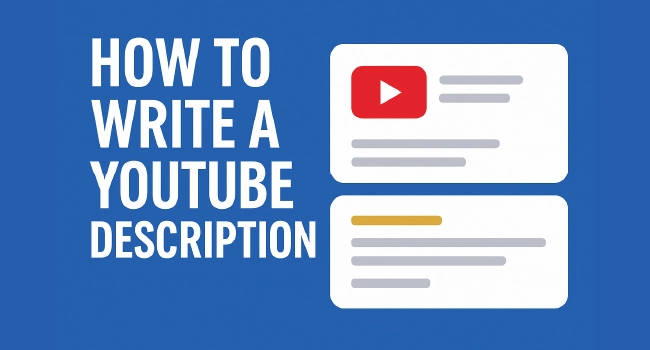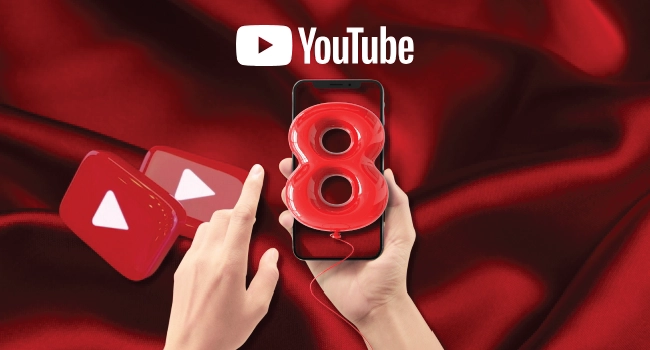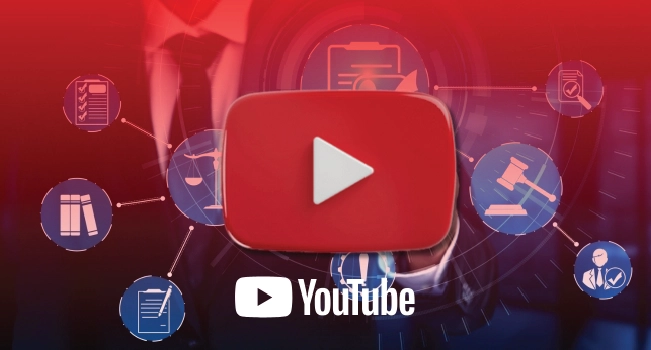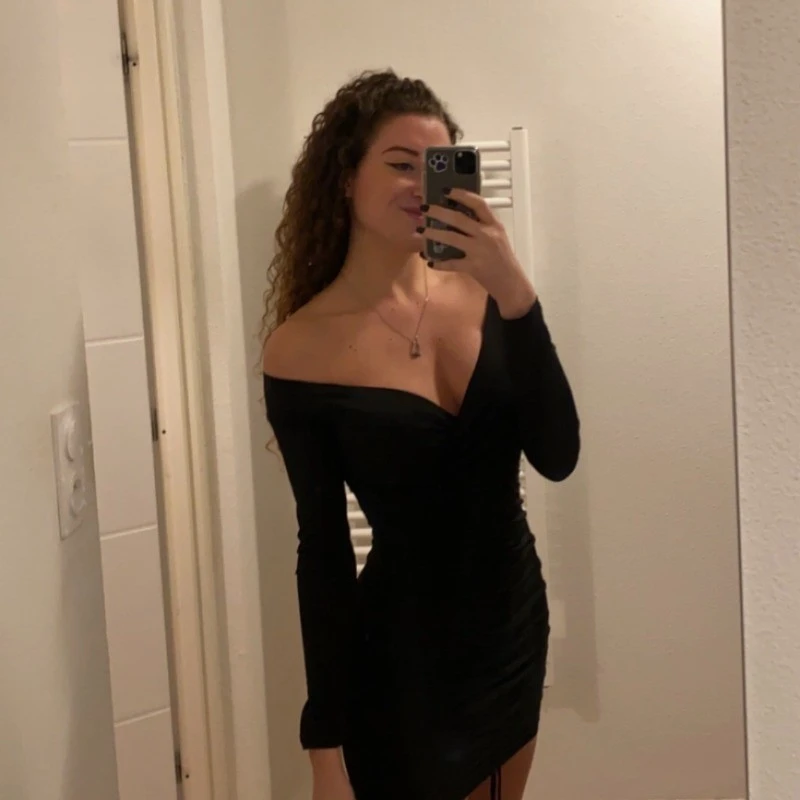
You’ve probably asked yourself how to write a YouTube description that actually helps your video get seen.
A well-written description can be the difference between a video that fades away and one that gets discovered, clicked, and watched.
Think of it as your video’s elevator pitch: short, clear, and convincing enough to make someone hit play. In just a few lines, you need to explain what your video is about, give viewers a reason to watch, and also provide YouTube with the right signals to show your content in search and suggested results.
Why YouTube Descriptions Matter
When you publish a video, the description plays a big role in how people and YouTube itself understand your content. It explains what your video covers, sets the right expectations, and gives search algorithms the context they need to recommend it.
Here's why it matters:
-
Search visibility: YouTube uses descriptions to understand context. A clear summary can help your video rank for the right keywords.
-
Click-through rate: The first two lines appear before the "Show more" button. If you grab attention here, more people will click.
-
Watch time boost: A useful description can guide viewers to chapters or related videos, keeping them on your channel longer.
-
Trust and credibility: When you explain what the video covers, viewers know they're in the right place.
The description works like a bridge between your title and the video itself.
8 Key Methods for Writing an Effective YouTube Description

Writing a strong description involves combining several methods that make your content easier to discover, more engaging to read, and more likely to convert viewers into subscribers. Below are eight proven methods that cover everything from your opening lines to templates you can reuse.
Core Elements of an Effective Description
A solid description balances clarity, detail, and flow. Think of it as your video's quick pitch and roadmap. The way you write it shapes how viewers and YouTube respond.
Strong first lines
The first two lines appear before the "Show more" button, so most viewers only see this part. Use it to explain the core benefit of your video in clear words.
Main summary
This is where you give more detail about what the video covers. Write as if you're telling a friend what they'll get from watching.
Clear structure
Long blocks of text can scare people away. Use short paragraphs or line breaks so the description feels easy to skim.
Supporting details
After the main summary, add anything that helps the viewer go further. This could be a playlist link for related videos or a resource you mention.
How to Write a YouTube Description for SEO
Learning how to write a YouTube description with search in mind doesn't mean stuffing it full of keywords. Instead, it's about weaving important phrases into natural sentences while keeping the text useful for real people.
Start by choosing one or two main keywords that match what someone would type into the search bar. Place them near the top of your description, then use related phrases naturally throughout the rest of the text. This helps YouTube connect your video with relevant searches without making it sound robotic.
Think about variations, too. For example, if your main keyword is "video editing tips," you might also mention "video editing tricks" or "learn to edit videos." Tools like TubeBuddy or vidIQ can help you discover these terms, but always test them against your own analytics.
This is also the right place to talk about structure. Clear sections, short paragraphs, and a simple flow give YouTube more context to work with and help viewers read without effort. If your video covers multiple steps, break them down in order. That way, you provide value while boosting your discoverability.
A quick side note: titles and descriptions often work together. Learning how to write a good YouTube title alongside a strong description gives your video the best chance of reaching the right audience.
Chapters, Formatting, and Viewer Experience
The way you organize and format the YouTube description shapes how both viewers and YouTube interact with your video. One of the most powerful tools here is chapters.
Adding YouTube chapter timestamps lets people jump straight to the part they want, which improves watch time and satisfaction. To set them up, list your timestamps in order, starting with 00:00 as the intro, followed by clear labels for each section.
Formatting also matters. Use short paragraphs, line breaks, and occasional bold or italics to highlight key points. For example, if you include a free resource link, making it bold helps it stand out without looking spammy.
When your description feels easy to read, viewers are more likely to stay engaged, click links, and even return for more videos. That extra clarity can also help YouTube's system identify important context, which may improve your chances of showing up in related searches.
Linking and Calls to Action
Links and calls to action guide viewers beyond the video itself. Where you place them matters just as much as what you say.
For long-form content, put the most important link near the top of your description so people see it before clicking "Show more." This could be a playlist, your website, or a resource you promised in the video.
Shorts work a bit differently. Since YouTube Shorts description links are not clickable, use creative workarounds. Point viewers to your channel profile link, add a related long-form video, or use shopping tags if your channel qualifies.
Calls to action should feel natural, not pushy. Instead of saying "subscribe now," explain the benefit: "Subscribe to catch more quick editing tips every week." You can also invite people to comment, share their experiences, or check out another video in a series.
By blending links and CTAs into your description, you create a clear path for viewers to follow. This keeps them engaged with your content while building stronger channel growth.
Default Templates and Reusable Blocks
Writing a fresh description for every video can be time-consuming. That's where a YouTube default description helps. In YouTube Studio, you can set up an upload default that automatically includes the links, credits, and disclosures you use often. This saves time and keeps your branding consistent across all videos.
A good default block usually includes your social links, website, standard call-to-action, and any legal notes such as music credits or sponsorship disclosures. Once that's in place, you only need to customize the first few lines of each description so they match the specific video.
For example, if you're creating a tutorial, your default might already include a link to your full playlist. All you do is update the top lines with a short summary of the new video. This balance between default structure and personal edits makes the process fast but still personal.
To make this even more practical, here's a quick set of sample templates you can adapt:
| Video Type | Example Description Snippet |
|---|---|
| Tutorial | "Learn how to set up your camera step by step. In this video, I'll walk you through the exact process so you can start shooting today." |
| Vlog | "Join me on a day exploring downtown. From hidden cafés to street art, I'll show you the best spots worth visiting." |
| Product Review | "Here's my honest take on the latest smartphone. I'll cover design, features, and real-world performance to help you decide if it's worth it." |
These examples show how structure and tone stay consistent while the details change. That's the power of combining templates with customization.
Compliance and Policy Essentials

A polished description only works if it also follows the rules. YouTube has clear policies on how descriptions should be used, and breaking them can hurt your channel.
First, avoid metadata spam. That means no long lists of keywords, repeated phrases, or irrelevant text. YouTube flags these as attempts to game the system. Instead, use natural language that actually describes your video.
Second, remember disclosures. If you include affiliate links or paid promotions, you must let viewers know. Adding a simple line like "This video contains affiliate links" is enough. This counts as a YouTube affiliate disclosure, and it helps you stay compliant with FTC guidelines.
Third, be careful with hashtags and links. A few well-placed hashtags at the end of your description can help with discovery, but stuffing dozens will look spammy. Links should be relevant and trustworthy. Sending viewers to risky sites can cause issues with your channel.
By following these guidelines, you ensure your descriptions remain effective while staying within YouTube's policies.
Advanced Optimization
Once you've covered the basics, it's time to fine-tune your descriptions for even better results. A good place to start is keeping an eye on YouTube description length. You get up to 5,000 characters, but that doesn't mean you need to use them all. Aim for a balance: enough detail to give value, but short enough to stay scannable.
Another useful tool is product tagging. If your channel qualifies, you can highlight products you talk about directly in your description. These show up as shoppable links, which is far more effective than dropping a raw URL. Pair this with clear wording so viewers understand what they're clicking.
Formatting is another overlooked trick. YouTube Studio now allows bold and italics, which help key details stand out. You can also use the corrections feature to add quick updates, which builds trust without editing the entire video.
Finally, think about localization. If you reach an audience across different countries, add translated descriptions and keep your boilerplate consistent across languages. It makes your content more welcoming and expands your reach.
Testing and iteration are key to finding what works best for your specific audience and content style.
Testing and Iteration
Learning how to write a YouTube description is not a one-time task. The best creators test different approaches to see what actually works. You can start by changing the structure of your first lines across similar videos and tracking which version gets more clicks.
YouTube Analytics is your best friend here. Focus on metrics like impressions, click-through rate, and average view duration. If a new description style leads to more people watching longer, you know you're on the right path.
It also helps to experiment with where you place calls to action. Try moving a playlist link higher in the description, or adjust the wording of your subscribe line. Even small changes can have a big impact when measured over time.
While you're experimenting with description styles, you may want an extra boost to speed things up. That's where our service for buying YouTube subscribers comes in.
Every subscriber comes from a real account with fast delivery, helping your channel look more credible while you continue growing it with great content.
Conclusion
Learning how to write a YouTube description is one of the most valuable skills you can pick up as a creator. A good description does more than explain your video it helps YouTube understand your content, gives viewers a reason to click, and guides them to stay longer on your channel.
When you apply the methods we covered: clear first lines, strong summaries, chapters, smart links, SEO, and templates, you create a description that works like a roadmap. It tells people exactly what they’ll get while giving your video the best chance to reach new audiences.
FAQs | Frequently Asked Questions |
Do chapters really help with SEO?
Yes. Adding chapters makes your video easier to navigate and can improve watch time, which YouTube sees as a positive signal. They also show up as key moments in search results.
How many hashtags should I use in a description?
Stick to two or three relevant hashtags. Adding too many can look spammy and distract from your message.
Are tags still important compared to descriptions?
Tags play a very small role today. Focus on your title, description, and chapters. These areas carry far more weight for search and suggested video placement.
Where do affiliate disclosures go in a description?
Place them toward the end of your description. A short note like “This video contains affiliate links” keeps you compliant and transparent.
